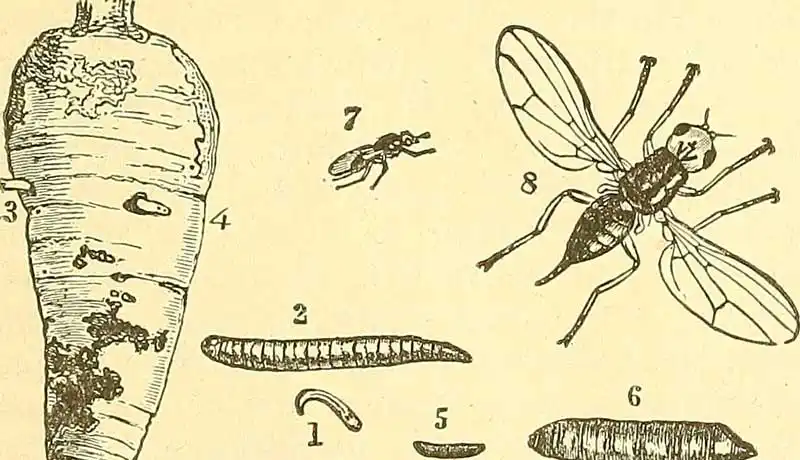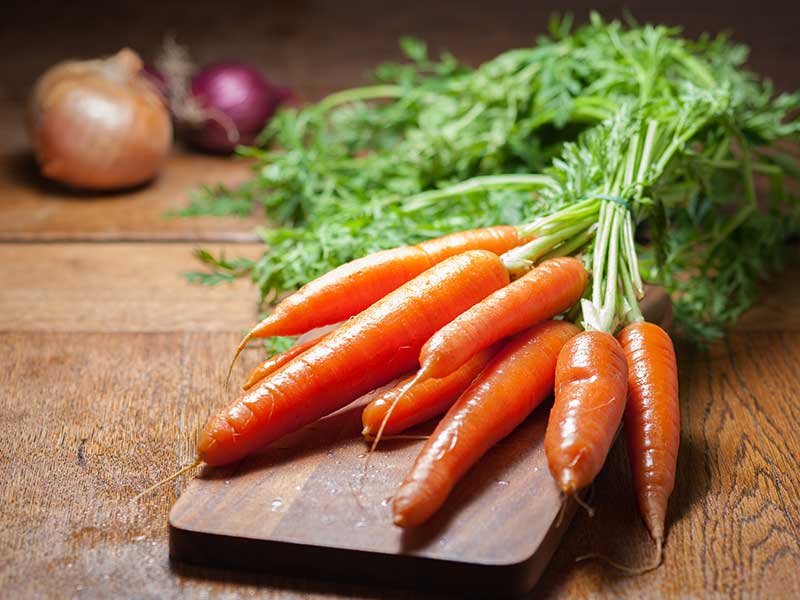Vegetable Gardening
How to Grow Carrots in Containers: A Complete Guide
In this article, we will guide you through the steps on how to grow carrots in containers. From choosing the right container, soil, and seed variety to proper watering and fertilizing techniques, we will cover everything you need to know to have a bountiful harvest of sweet and crunchy carrots.
Why Grow Carrots in Containers?
Carrots are a staple vegetable that many people love to grow in their gardens. However, not everyone has the luxury of having a garden to grow vegetables in. Luckily you can grow carrots in containers. It’s a great option for those who live in apartments, have limited space, or want to have fresh veggies right on their balcony or patio.
Containers are also ideal for gardeners who have poor soil conditions or limited mobility. In addition, growing carrots in containers allows you to control the growing environment, making it easier to manage pests and diseases, as well as water and fertilizer requirements.
Choosing the Right Container
First things first, you need to choose the right container for your carrot plants. You can use any type of container for growing carrots, including plastic, ceramic, or even recycled materials like old buckets. Grow bags are also a good option. However, a rectangular or square container is a better option than a round one as it maximizes the space available for growing.
The container should be at least 12 inches deep to accommodate the long root system of the carrot. It should also be wide enough to allow the plants to grow and spread out. Be sure the container has plenty of drainage holes to prevent waterlogging.
Preparing the Soil
Carrots prefer well-draining, loose soil with a pH level between 6.0 and 6.8. You can buy potting soil that is specifically formulated for container gardening or make your own by mixing equal parts of compost, peat moss, and vermiculite.
Before planting the seeds, loosen the soil in the container using a small hand cultivator or trowel. Make sure the soil is moist but not soaking wet. Carrot seeds need moisture to germinate, but too much water can cause them to rot.
The Best Varieties to Grow Carrots in Containers
When it comes to growing carrots in containers, it’s important to choose a variety that is suitable for small spaces. Look for carrot varieties that have shorter roots and are more compact, as they are better suited to container gardening.

Some of the best carrot varieties to grow in containers include:
- ‘Nantes‘: This variety produces straight, cylindrical roots that are ideal for containers. They have a sweet, crisp flavor and grow to about 6 inches long.
- ‘Little Finger‘: As the name suggests, ‘Little Finger’ is a small, slender carrot that’s perfect for growing in containers. The roots are about 3 inches long and have a sweet flavor.
- ‘Paris Market‘: This round, bite-sized carrot is perfect for containers. It grows quickly and has a sweet, mild flavor.
- ‘Thumbelina‘: Another small, round carrot, ‘Thumbelina’ is perfect for growing in shallow containers. It has a sweet, tender flavor and reaches about 2 inches in diameter.
- ‘Danvers‘: This heirloom variety is known for its deep orange color and sweet flavor. It grows to about 7 inches long and is a great choice for deeper containers.
- ‘Scarlet Nantes‘: This is a slightly sweeter version of the classic ‘Nantes’ carrot. It has a bright orange color and is perfect for growing in small containers.
- ‘Kuroda‘: This Japanese variety produces long, slender roots that are perfect for containers. They have a sweet, crunchy flavor and are great for snacking.
- ‘Bolero‘: This hybrid variety produces large, straight roots that are perfect for deep containers. They have a sweet, crisp flavor and are great for cooking.
- ‘Purple Haze‘: This unique variety produces purple-skinned roots with a bright orange interior. They have a sweet, slightly spicy flavor and are perfect for growing in shallow containers.
- ‘Dragon‘: This variety produces bright orange, cylindrical roots that are perfect for containers. They have a sweet, slightly spicy flavor and are great for snacking.
Planting the Seeds
Once you have prepared the soil and chosen the right seed variety, it’s time to plant the seeds. Sow the seeds thinly on top of the soil. Using a seed sower comes in handy for the tiny carrot seeds. Once sown, carefully cover the seeds with a quarter-inch layer of soil. Water the soil gently using a watering can or a spray bottle. Water slowly so the seeds don’t float away or clump together.
Carrot seeds can take anywhere from 7 to 21 days to germinate, depending on the soil temperature and moisture level. Keep the soil moist but not waterlogged during this time.
Plant Care: Grow Carrots in Containers
Thinning the Seedlings
It’s essential to thin out the seedlings once they start to grow. Carrot plants need space to grow, and overcrowding can result in stunted or misshapen roots. Thin the plants to about 1-2 inches apart, depending on the size of the container and the variety of carrots you’re growing. You can use scissors or a small knife to snip off the excess seedlings at the soil level. Don’t pull them out as it can disturb the roots of the remaining plants.
Proper Watering
Proper watering is crucial to the success of your carrot plants. Carrots require consistent moisture to grow properly. Check the soil moisture level by sticking your finger into the soil. If the soil feels dry to the touch, it’s time to water your plants. A moisture meter is also a great tool to ensure the proper moisture level of the soil.
Make sure to water the plants regularly, especially during dry spells. Water slowly and deeply, making sure that the water reaches the root zone. Underwatering can cause the carrots to become tough and woody. However, soggy soil can cause the roots to rot.
Fertilizing Carrots
Carrots are heavy feeders and require regular fertilization. To promote healthy growth, fertilize the plants every two to three weeks with a water-soluble fertilizer that is high in phosphorus. Avoid fertilizers that are high in nitrogen as they can cause the plants to produce more foliage than roots. You can also use organic fertilizers like compost or aged manure to provide your plants with the necessary nutrients.
Pest and Diseases

Carrot plants are susceptible to pests and diseases. Below is a table with some common problems and how to treat them.
| Pest/Disease | Symptoms | Treatment |
|---|---|---|
| Carrot rust fly | Leaves turn yellow and wilt, roots have tunnels and rust-colored spots | Cover plants with floating row covers, use yellow sticky traps, rotate crops |
| Carrot weevil | Leaves turn yellow, wilt, and have notches; roots have tunnels and holes | Use insecticidal soap, rotate crops |
| Root knot nematodes | Roots have knots or galls | Rotate crops, use soil solarization, plant nematode-resistant varieties |
| Powdery mildew | White or gray powdery coating on leaves | Use fungicidal spray, improve air circulation |
| Aster yellow phytoplasma | Leaves turn yellow and have thickened veins; roots are stunted and twisted | Remove and destroy infected plants, control leafhoppers |
| Damping off | Seedlings wilt and die, stems turn brown or black | Improve drainage, use sterile potting mix, avoid overwatering |
To help prevent these problems, keep the plants healthy by providing them with adequate water and fertilizer. You can also use organic pest control methods like neem oil, insecticidal soap, or garlic spray to keep pests at bay. More info about carrot pests and diseases.
Harvesting: Grow Carrots in Containers
Carrots are usually ready to harvest 60-80 days after planting, depending on the variety and growing conditions. You can check if the carrots are ready by gently pulling out one from the soil. If the carrot is the right size and shape, you can harvest the rest of the carrots. If not, wait for a week and check again.

After You Harvest
- Remove the tops: Cut off the carrot tops, leaving about an inch of stem. The tops can be composted or used in recipes, like pesto or soup.
- Wash the carrots: Rinse the carrots with cool water to remove any dirt or debris. You can use a vegetable brush to scrub them gently if necessary.
- Store the carrots: Depending on your preferences, you can store the carrots whole or cut them into pieces. For short-term storage, you can place them in the refrigerator in a plastic bag or container. For long-term storage, you can store them in a cool, dry place like a root cellar or basement.
Conclusion
It is a fun and rewarding experience to grow carrots in containers and can be enjoyed by gardeners of all levels. With the right container, soil, seed variety, and care, you can have a bountiful harvest of sweet and crunchy carrots that are perfect for snacking, cooking, or juicing.
Remember to choose a deep and wide container, use well-draining soil, sow the seeds thinly, water and fertilize regularly, thin out the seedlings, and keep an eye out for pests and diseases. With these tips and tricks, you can grow healthy and delicious carrots in your very own container garden.
FAQ: Growing Carrots
What month do you plant carrots?
You can plant carrots in the spring, starting as early as 2-3 weeks before the last expected frost date, or in the fall, up to 10 weeks before the first expected frost date. The ideal soil temperature for planting carrots is between 50-85°F.
Do carrots like shade or sun when planting?
Carrots prefer full sun but can tolerate partial shade, especially in hotter climates. If you are growing carrots in a hot area, consider providing some afternoon shade to prevent the soil from drying out too quickly.
Do carrots grow better in spring or fall?
Carrots can be grown in both spring and fall, but many gardeners prefer to grow them in the fall. Fall carrots tend to have a sweeter flavor and a better texture, as the cooler temperatures help to convert starches into sugars. Additionally, fall carrots are less likely to be affected by pests and diseases than spring carrots.
Are carrots heat tolerant?
Carrots are cool-season crops and prefer temperatures between 60-70°F. They can tolerate some heat but may become bitter or woody if exposed to prolonged heat. If you are growing carrots in a hot area, consider providing some shade or planting in the fall.
Why are my container carrots so small?
There are several reasons why container carrots may be small, including inadequate soil depth, overcrowding, poor soil quality, and irregular watering. However, the most common reason for small carrots being grown in containers is due to the soil being too dense. To improve carrot size, ensure that the container is deep enough, thin out seedlings as they grow, use a high-quality potting mix, and water consistently.
How many carrots can you grow in a 5 gallon bucket or grow bag?
You can grow up to 10-12 carrots in a 5-gallon bucket or grow bag, depending on the variety and spacing. Make sure to use a potting mix that is light and well-draining, and keep the soil consistently moist.






